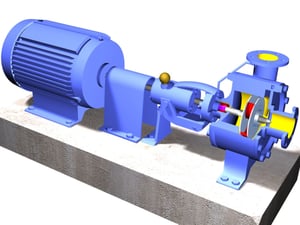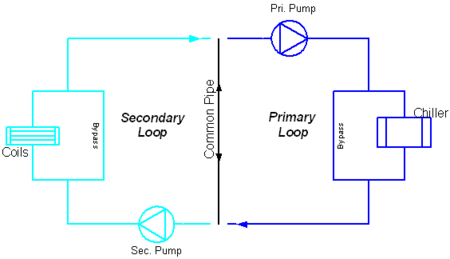Energy Efficiency | June 10, 2020
HVAC Overview Part III: Pumps
While no two HVAC efficiency projects are the same, energy optimizations often encounter the same four, primary mechanical functions. For the third and final blog in our three-part series on the four fundamentals of HVAC equipment, we wrap up the systems by looking at how pumps work. In the first two installments in series, we broke down three of the foundational elements: heating and cooling, and movement. Now, we address the final piece of a mechanical system overview by exploring the movement of water via pumps.

The importance of pumps in mechanical systems
Water is required to heat and cool facilities via mechanical systems. The most common pumps move water through a series of piping within an HVAC configuration.
The concept of a pump is simple: an impeller is coupled to a shaft, with the other shaft end connected to the motor (unless it is a direct drive pump with the shaft connected directly from motor to impeller).
The design of a pump in the system, however, can be complex. The pump is in place to move water, yes, but the variables in which the water is moved are very important. Flow rate based on pipe size will result in a certain velocity. That velocity needs to be within the design specs of the terminal units in order to achieve proper heat exchange.
Aside from the flow rate, each length of pipe, the fitting, valve and terminal unit all come with an associated pressure drop or restriction to flow. The pump needs to be sized with the correct discharge pressure, commonly referred to as “feet of head,” which is designed to overcome the total pressure drop in the system and allow the water to make its way back to the pump suction.
Follow these three steps to evaluate the pumps and piping in your facility:
Before you begin, be sure to specify whether you’re circulating chilled water, hot water or glycol. Then, tackle the following steps:
-
Identify which type of system is being used. The piping and pumping combination matters for what you are trying to accomplish in the space.
-
Accurately size the piping. Pumps designated for moving water through buildings need to be the right size in order to work properly. If a pipe is too big, it can create a laminar or a no-flow situation. If a pipe is too small, you can create a turbulent (too high of a velocity) flow which will prevent proper heat exchange.
-
Make sure the VFD (Variable Frequency Drive) is moving at the appropriate rate.
simple definition | Variable Frequency Drives (VFDs)Variable Frequency Drives control the frequency and voltage of a motor which drives pumps and fans in mechanical equipment. VFDs convert the input frequency and voltage to a lower frequency and voltage based on the demand required from the system. This will decrease the motor speed and torque requirements when the system is not fully loaded, resulting in less fluid movement. |
In today’s HVAC technology, almost every pump and fan (unless constant speed) will ideally come equipped with a VFD. However, a lot of legacy equipment can benefit from the addition of VFDs to improve efficiency and lower utility costs. Either way, the ability to slow down motor speed based on demand results in efficiency gains because the electrical usage on the motor decreases.
Pump types and specifications
Some pump types need to follow certain specifications based on the mechanical system they serve:
-
Pumps which move potable water need to be NSF 61 certified. This is the federal requirement that prevents high amounts of lead in your drinking water.
-
Pumps located outside will typically have a TEFC motor enclosure to ensure no moisture can get into the motor windings.
-
Pumps in a corrosive environment should come with stainless steel wetted parts. Inside of the pumps the bearings, shaft, etc. should also be stainless steel.
Every situation is unique to the application at hand, but adequately sizing and specifying the pump is a critical part to any HVAC system.
Types of piping systems involving pumps
There are two typical piping configurations in most HVAC systems: Primary/Secondary (P/S) and Variable Primary. Both move fluid between heating and cooling systems. The essential difference between these piping systems is that variable primary pumping does not have secondary circulator pumps and a P/S piping configuration does.
Primary Secondary
This two-pump system has been the go-to since it was patented 1964 by Russ Geaslen.
Primary/Secondary (P/S) piping involves a primary loop and secondary loop. A P/S piping system is designed to decouple the secondary system from the primary system, making the two piping arrangements act independently of each other. This allows for control via a mechanical means (pump) because the system loops are both operating at different flow rates. This guarantees that each loop is satisfied for their individual flow rate requirements.

Source: bigladdersoftware.com
Variable Primary
Because a variable primary system does not have secondary circulator pumps, the primary pumps are sized to handle the flow and pressure drop of the entire system.
A variable primary system is generally the lower-cost installation option as it removes the need for secondary pumps on each secondary circuit. This means less pump cost, less piping cost and less electrical cost. These systems can be a more efficient option as they require less pumping horsepower.
.png?width=500&name=HVAC%20part%20III%20(1).png)
How can you improve the efficiency of your building?
Now that we’ve covered four foundational elements of HVAC – heating, cooling, movement and pumps – it’s time to talk about the efficiency of these systems.
Every project we undertake is custom. That is the nature of efficiency; it’s not one-size-fits-all. If you have a preferred brand you want used in the build, a required payback time period that needs met or a solid number of emissions you need reduced, these all factor into how a company designs strategies for you to achieve maximum savings and the utmost sustainability for your building and all of its mechanical equipment.
If you want to learn more about HVAC systems check out HVAC Overview I and HVAC Overview II or look through the other educational resources we provide!
HVAC Overview Pt. I - Heating and Cooling »
HVAC Overview Pt. II - RTUs and AHUs »
Related Posts
Discover more content and insights from Mantis Innovation

The Cost of Inaction: Why Businesses Should Act Now on Energy Efficiency
In today's fast-paced business environment, the financial and operational losses businesses incur by delaying energy efficiency improvements, the "cost of inaction," is more relevant than ever.

In today’s AI era, human intelligence is the key to data center facility and energy optimization
Nowhere else in modern industry do artificial and human intelligence converge with such transformative potential as in the world of data centers. As AI's extraordinary growth accelerates demand for

Your Guide to LED Lighting for Business and Commercial Buildings
Never to be underestimated, LED lighting and well-designed lighting retrofits and upgrades offer businesses big improvements like reduced energy costs, reduced emissions, and improved working

Five Trends Driving Data Center Facility Energy Optimization
Today’s digital economy, commercial and industrial digitalization, and the recent explosion in artificial intelligence and machine learning (AI/ML) powered computing are driving massive growth in